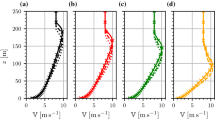Abstract
We study bulk formulations for the boundary-layer height which are currently in use for atmospheric modelling. The formulations are based on various forms of the Richardson number, and these are evaluated with Cabauw field data in stable conditions. Results for both a large-eddy simulation model and anE-ε turbulence closure model for neutral boundary layers are also utilised. An updated formulation is introduced, which combines the effects of shear in the outer region of the boundary layer with surface friction. The updated formulation has a better performance for neutral boundary layers with upper level stratification. The findings are illustrated with a single-column model for a case with relatively high winds over the tropical ocean including shallow cumulus convection, and for a case with fair weather over land. We also show that for stable conditions, the updated formulation performs better than estimates on the basis of surface friction alone.
Similar content being viewed by others
References
André, J. C.: 1983, ‘On the Variability of the Nocturnal Boundary-Layer Depth’,J. Atmos. Sci. 40, 2309–2311.
Andrén, A. and Moeng, C.-H.: 1993, ‘Single-Point Closures in a Neutrally Stratified Boundary Layer’,J. Atmos. Sci. 50, 3366–3379.
De Baas, A. F. and Driedonks, A. G. M.: 1985, ‘Internal Gravity Waves in a Stably Stratified Boundary Layer’,Boundary-Layer Meteorol. 31, 303–323.
Duynkerke, P. G.: 1988, ‘Application of theE-ε Turbulence Closure Model to the Neutral and Stable Atmospheric Boundary Layer’,J. Atmos. Sci. 45, 865–880.
Fouquart, Y. and Bonnell, B.: 1980, ‘Computation of Solar Heating of the Earth’s Atmosphere: A New Parameterization’,Beitr. Phys. Atmosph. 53, 35–62.
Garratt, J. R.: 1982, ‘Observations in the Nocturnal Boundary Layer’,Boundary-Layer Meteorol. 22, 21–48.
Grant, A. L. M.: 1992, ‘The Structure of Turbulence in the Near-Neutral Atmospheric Boundary Layer’,J. Atmos. Sci. 49, 226–239.
Hack, J.: 1994, ‘Parameterization of Moist Convection in the NCAR Community Climate Model, CCM2’,J. Geophys. Res. 99, 5551–5568.
Hanna, S. R.: 1969, ‘The Thickness of the Planetary Boundary Layer’,Atmos. Environ. 3, 519–536.
Holland, J. Z. and Rasmusson, E. M.: 1973, ‘Measurement of Atmospheric Mass, Energy and Momentum Budgets over a 500 km Square of Tropical Ocean’,Mon. Wea. Rev. 101, 44–55.
Holtslag, A. A. M. and Boville, B. A.: 1993, ‘Local versus Nonlocal Boundary-Layer Diffusion in a Global Climate Model’,J. Climate 6, 1825–1842.
Holtslag, A. A. M., van Meijgaard, E., and de Rooij, W. C.: 1995, ‘A Comparison of Boundary Layer Diffusion Schemes in Unstable Conditions over Land’,Boundary-Layer Meteorol. 76, 69–95.
Holtslag, A. A. M. and Nieuwstadt, F. T. M.: 1986, ‘Scaling the Atmospheric Boundary Layer’,Boundary-Layer Meteorol. 36, 201–209.
Kim, J. and Mahrt, L.: 1992, ‘Simple Formulation of Turbulent Mixing in the Stable Free Atmosphere and Nocturnal Boundary Layer’,Tellus 44A, 381–394.
Kitaigorodskii, S. A. and Joffre, S. M.: 1988, ‘In Search of a Simple Scaling for the Height of the Stratified Atmospheric Boundary Layer’,Tellus 40A, 419–433.
Koracin, D. and Berkowicz, R.: 1988, ‘Nocturnal Boundary-Layer Height: Observations by Acoustic Sounders and Predictions in Terms of Surface-Layer Parameters’,Boundary-Layer Meteorol. 43, 65–83.
Large, W. G., Mc Williams, J. C., and Doney, S. C.: 1994, ‘Oceanic Vertical Mixing: A Review and a Model with a Nonlocal Boundary-Layer Parameterization’,Rev. Geophys. 32(4), 363–403.
Mahrt, L.: 1981, ‘Modelling the Depth of the Stable Boundary Layer’,Boundary-Layer Meteorol. 21, 3–19.
Mahrt, L.: 1985, ‘Vertical Structure and Turbulence in the Very Stable Boundary Layer’,J. Atmos. Sci. 42, 2333–2349.
Mahrt, L., Heald, R. C., Lenschow, D. H., Stankov, B. B. and Troen, I.: 1979, ‘An Observational Study of the Nocturnal Boundary Layer’,Boundary-Layer Meteorol. 17, 247–264.
Moeng, C.-H. and Sullivan, P. P.: 1994, ‘A Comparison of Shear- and Buoyancy-Driven Planetary Boundary-Layer Flows’,J. Atmos. Sci. 51, 999–1022.
Morcrette, J.-J.: 1991, ‘Radiation and Cloud Radiative Properties in the European Centre for Medium Range Weather Forecasting System’,J. Geophys. Res. 96, 9121–9132.
Nieuwstadt, F. T. M.: 1984, ‘The Turbulent Structure of the Stable, Nocturnal Boundary Layer’,J. Atmos. Sci. 41, 2202–2216.
van Pul, W. A. J., Holtslag, A. A. M., and Swart, D. P. J.: 1994, ‘A Comparison of ABL Heights Inferred Routinely from Lidar and Radiosondes at Noontime’,Boundary-Layer Meteorol. 68, 173–191.
Siebesma, A. P. and Cuijpers, J. W. M.: 1995, ‘Evaluation of Parametric Assumptions for Shallow Cumulus Convection’,J. Atmos. Sci. 52, 650–666.
Siebesma, A. P. and Holtslag, A. A. M.: 1996, ‘Model Impacts of Entrainment and Detrainment Rates in Shallow Cumulus Convection’,J. Atmos. Sci. 53, 2354–2364.
Tiedtke, M.: 1989, ‘A Comprehensive Mass Flux Scheme for Cumulus Parameterization in Large-Scale Models’,Mon. Wea. Rev. 117, 1779–1800.
Troen, I. and Mahrt, L.: 1986, ‘A Simple Model of the Atmospheric Boundary Layer; Sensitivity to Surface Evaporation’,Boundary-Layer Meteorol. 37, 129–148.
van Ulden, A. P. and Holtslag, A. A. M.: 1985, ‘Estimation of Atmospheric Boundary Layer Parameters for Diffusion Applications’,Boundary-Layer Meteorol. 24, 1196–1207.
van Ulden, A. P. and Wieringa, J.: 1996, ‘Atmospheric Boundary Layer Research at Cabauw’,Boundary-Layer Meteorol. 78, 39–69.
Wetzel, P. J.: 1982, ‘Toward Parameterization of the Stable Boundary Layer’,J. Appl. Meteorol. 21, 7–13.
Author information
Authors and Affiliations
Rights and permissions
About this article
Cite this article
Vogelezang, D.H.P., Holtslag, A.A.M. Evaluation and model impacts of alternative boundary-layer height formulations. Boundary-Layer Meteorol 81, 245–269 (1996). https://doi.org/10.1007/BF02430331
Accepted:
Issue Date:
DOI: https://doi.org/10.1007/BF02430331




